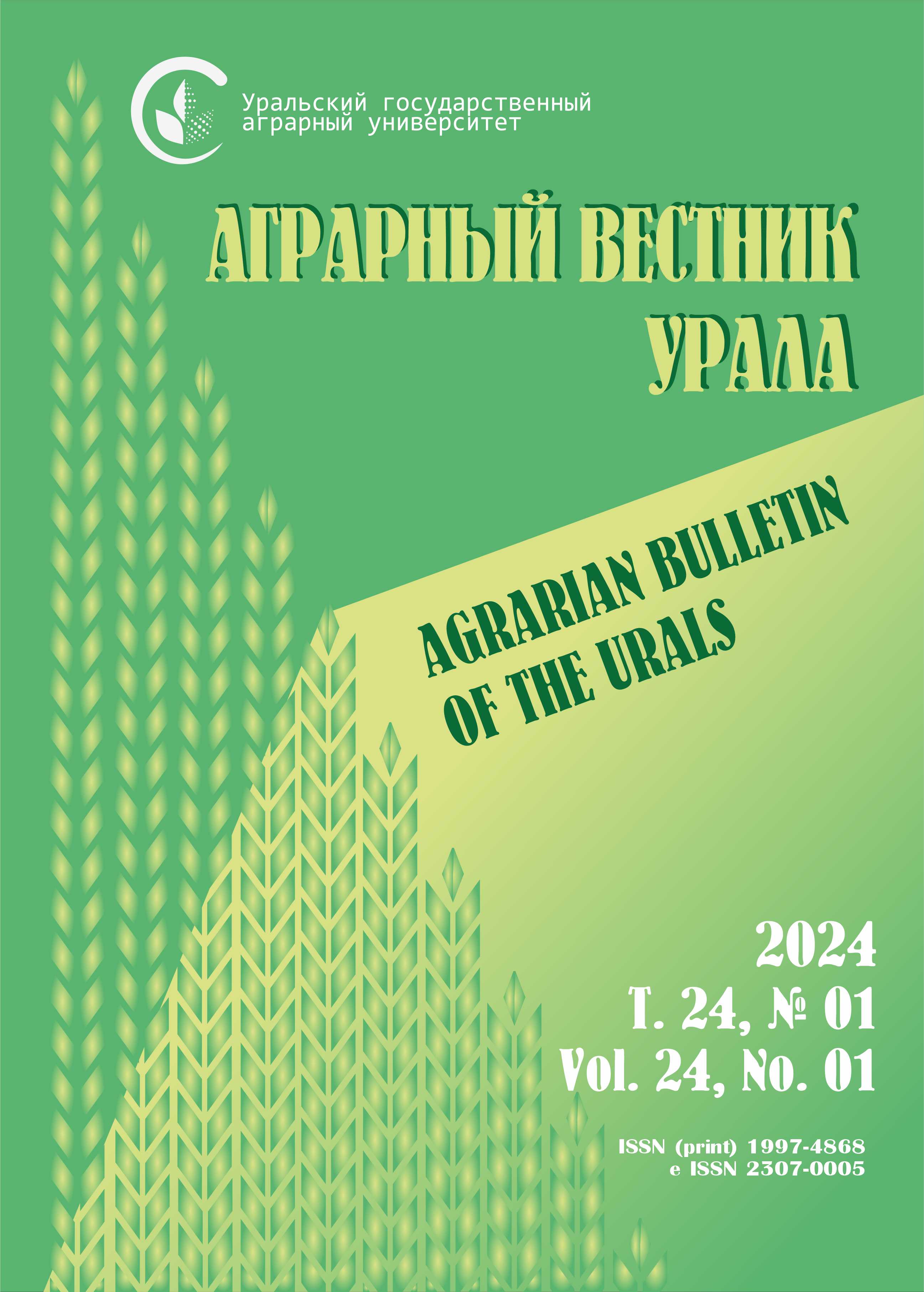Russian Federation
Abstract. The article highlights the results of scientific and economic experience on highly productive dairy cows of black-and-white breed in the second half of lactation. The purpose - evaluation of the possibility of using a new lyophilized feed additive “Bonaka-APK” in the diets of dairy cows to increase their productivity and milk quality indicators. Studied the productive effect of the feed additive “Bonaka-APK” on dairy cows. Scientific and economic experience was conducted in the farm of the OSP “Novator 1” (Gulkevichi district, Krasnodar Territory) in 2021–2022. Research objectives to study the effect of feeding the feed additive "Bonaka-APK" on milk productivity and quality indicators of cow milk. Methods. The studies were carried out on two groups of dairy cows, formed by the method of pairs of analogues. Feeding ration of dairy cows of black-and-white breed with a live weight of 550.0 ± 40.0 kg and a milk yield of 16.0 ± 3.0 kg per day contained: 170 MJ OE, 1582.0 g of digestible protein and 4100.0 g of crude fiber, including 1844.0 g of starch. The sugar-protein ratio in the diet is – 0.83. There were 93.1 g of digestible protein per 1 energy feed unit. The experimental group, in addition to the main diet as part of the compound feed, received a probiotic complex “Bonaka-APK” in the amount of 0.02 kg per 1 head, once a day before milking. Results. The use of the biotechnological complex “Bonaka-APK” as an additive to compound feed, for the accounting period, made it possible to significantly increase the milk yield of 1 cow in the experimental group by 24.6 %, and in terms of 4.0% fat content – by 26.0 % compared with control. The content of fat in the milk of the experimental groups did not differ significantly, and the content of the mass fraction of protein in the milk of the experimental group was significantly higher by 0.4% compared to the control. Scientific novelty. For the first time, a new, developed complex “Bonaka-APK” was tested on dairy cows.
black-and-white, dairy cows, feed additive, biotechnological complex, milk
1. Mcfarland L., Huang Y., Wang L., Malfertheiner P. Systematic review and meta-analysis: multi-strain probiotics as adjunct therapy for helicobacter pylori eradication and prevention of adverse events // United European Gastroenterology Journal. 2019. No. 4 (4). Rr. 546-561. DOI:https://doi.org/10.1177/2050640615617358. EDN: https://elibrary.ru/YXOBBL
2. Levina E. Yu. Zabashta N. N., Golovko E. N., Sinel'schikova I. A., Arakcheeva E. N. «BONAKA-APK» pri otkorme telok na myaso // Sbornik nauchnyh trudov Krasnodarskogo nauchnogo centra po zootehnii i veterinarii. Krasnodar, 2022. T. 11. № 2. S. 13-19. DOI:https://doi.org/10.48612/sbornik-2022-2-3. EDN: https://elibrary.ru/ELQOOF
3. Zabashta N. N., Golovko E. N., Lisovickaya E. P. [i dr.] Aflatoksin AFM1: Bezopasnost' i kachestvo moloka // Veterinariya Kubani. 2020. № 1. S. 11-14. DOI:https://doi.org/10.33861/2071-8020-2020-1-11-14. EDN: https://elibrary.ru/MGCTKI
4. Markowiak P., Śliżewska K. The role of probiotics, prebiotics and synbiotics in animal nutrition // Gut Pathogens. 2020. No. 10 (21). DOI: 10.1186.
5. Zabashta N. N., Golovko E. N., Men'shenin V. V., Lisovickaya E. P., Sinel'schikova I. A. Myasnaya produktivnost' bychkov, vyraschivaemyh na organicheskuyu govyadinu // Vestnik KrasGAU. 2022. № 9 (186). S. 145-151. DOI: 10.36718. DOI: https://doi.org/10.36718/1819-4036-2022-9-145-151; EDN: https://elibrary.ru/YTQIKI
6. Levina E. Yu.; OOO NC «Bonaka». Kormovaya probioticheskaya dobavka dlya ptic. Patent RU 2 742 867 C1. Zayavl. 11.01.2021; Opubl. 11.02.2021. 26 s.
7. Ozheredova N. A., Svetlakova E. V., Verevkina M. N. et al. The influence of a complex of probiotic cultures on intensity of development the animals. Research Journal of Pharmaceutical // Biological and Chemical Sciences. 2016. Vol. 7. No. 2. Pp. 716-720. EDN: https://elibrary.ru/RFXCEE
8. Gurevich K. G., Nikityuk D. B., Nikonov E. L., Zaborova V. A. [i dr.] Rol' probiotikov i mikrobioty v pischevarenii, metabolizme nutrientov, gormonov i podderzhanii gormonal'nogo fona // Profilakticheskaya medicina. 2018. 21 (3). S. 45-50. DOI:https://doi.org/10.17116/profmed201821345. EDN: https://elibrary.ru/USRQUI
9. Sulyga N. V., Katkov K. A., Kovaleva G. P., Lapina M. N. Vliyanie geneticheskih faktorov na produktivnost' korov cherno-pestroy porody v zavisimosti ot vozrasta v laktaciyah // Izvestiya Gorskogo gosudarstvennogo agrarnogo universiteta. 2023. T. 60-1. S. 53-59. DOI:https://doi.org/10.54258/20701047_2023_60_1_53. EDN: https://elibrary.ru/SWXDAZ
10. Yyldyrym E. A., Laptev G. Yu., Il'ina L. A. i dr. Taksonomicheskaya i funkcional'naya harakteristika mikrobioty rubca laktiruyuschih korov pod vliyaniem probiotika cellobakterina // Sel'skohozyaystvennaya biologiya. 2020. T. 55. № 6. S. 1204-1219. DOI:https://doi.org/10.15389/agrobiology.2020.6.1204rus. EDN: https://elibrary.ru/DIXEBM
11. Zabashta N. N., Golovko E. N., Sinel'schikova I. A., Lisovickaya E. P., Sarbatova N. Yu. Sravnitel'nye issledovaniya inter'era bychkov na otkorme // Molochnoe i myasnoe skotovodstvo. 2022. № 4. S. 57-60. DOI: 10.33943. DOI: https://doi.org/10.33943/MMS.2022.69.94.010; EDN: https://elibrary.ru/HUMZTK
12. Zabashta N., Golovko E., Sinelshchikova I., Visokopoyasnaya A. Beef for baby food from bulls and castrates // E3S Web of Conferences XIII International Scientific and Practical Conference. State and Prospects for the Development of Agribusiness. 2020. Vol. 175. Article number 08008. DOI:https://doi.org/10.1051/e3sconf/202017508008. EDN: https://elibrary.ru/KVONAU
13. Pogodaev V. A., Rachkov I. G., Kononova L. V., Botasheva V. A., Smirnova L. M. Innovacionnye rossiyskie preparaty i ih ispol'zovanie v svinovodstve // Zootehniya. 2022. № 9. S. 13-16. DOI:https://doi.org/10.25708/ZT.2022.73.25.004. EDN: https://elibrary.ru/OCSSPN
14. Kovaleva G. P., Lapina M. N., Sulyga N. V., Vitol V. A. Narushenie obmena veschestv kak odin iz faktorov, snizhayuschih vosproizvoditel'nye sposobnosti korov cherno-pestroy porody // Zootehniya. 2021. № 11. S. 12-14. DOI:https://doi.org/10.25708/ZT.2021.85.60.004 EDN: https://elibrary.ru/WUSSEL
15. Trubina I. A., Sycheva O. V., Skorbina E. A. Myasnoy produkt funkcional'noy napravlennosti s natural'nymi rastitel'nymi komponentami // Innovacionnye podhody k razvitiyu ustoychivyh agrarno-pischevyh sistem: materialy Mezhdunarodnoy nauchno-prakticheskoy konferencii. Volgograd, 2022. S. 335-339. EDN: https://elibrary.ru/RROKDJ









